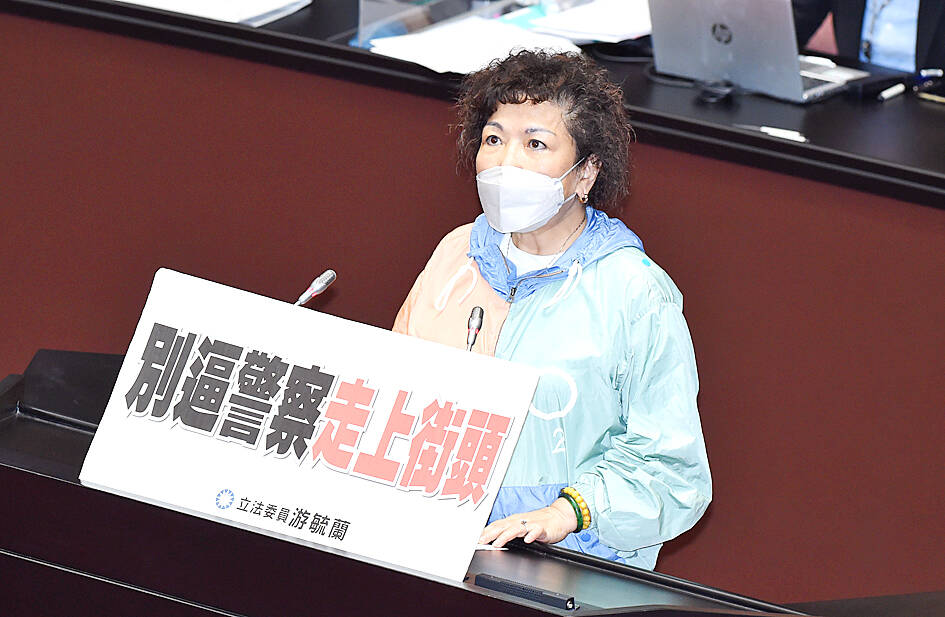Chinese Nationalist Party (KMT) Legislator Sandy Yu (游毓蘭) on Sunday called for new legislation to standardize road and sidewalk designs to better protect pedestrians.
The proposal came in the wake of an incident last month in which a mother and child were killed by a bus while crossing an intersection in Taichung, as well as the publication of a CNN article that called Taiwan a “living hell” for pedestrians.
Yu said there were 410 pedestrian fatalities in Taiwan last year, of which 23 involved people who were killed while using pedestrian crossings.

Photo: Liao Chen-hui, Taipei Times
The “pedestrian-unfriendly” traffic environment stems in part from regulations that enable road design authorities to build discontinuous sidewalks that are easily obstructed or no sidewalks at all, she said.
Yu said legislation should be drafted to set strict national standards for pedestrian infrastructure construction.
A nationwide survey should be conducted to identify areas that are risky for pedestrians, she said, citing inadequate surface markings and signage at accident-prone sites.
Yu said lighting should be improved and more pedestrian islands should be constructed at intersections where large numbers of incidents involving pedestrians occur.
There should be safety certifications for roads and intersections of a certain size, she added.
Taiwan Traffic Safety Association vice president Lin Chih-hsueh (林志學) said poor road design is to blame for the high number of incidents involving pedestrians, rather than Taiwan’s driving culture.
Lin said the government tends to claim that individual drivers who are involved in such incidents are to blame, while it neglects the root cause of the problem.
Lin echoed Yu’s comments that national standards for road construction are needed, citing Japan’s Road Construction Ordinance as a potential guideline for legislators.
A comprehensive effort should be made to identify and redesign dangerous intersections, he said.
There is a growing international trend toward making intersections smaller, which entices drivers to reduce their speed as they approach them, giving them more time to react to pedestrians, he said.
Road planners should also seek to increase visibility at intersections by ensuring that drivers’ view of sidewalks is not obstructed, Lin said, adding that traffic islands would also contribute to solving the issue.

SHIPS, TRAINS AND AUTOMOBILES: The ministry has announced changes to varied transportation industries taking effect soon, with a number of effects for passengers Beginning next month, the post office is canceling signature upon delivery and written inquiry services for international registered small packets in accordance with the new policy of the Universal Postal Union, the Ministry of Transportation and Communications said yesterday. The new policy does not apply to packets that are to be delivered to China, the ministry said. Senders of international registered small packets would receive a NT$10 rebate on postage if the packets are sent from Jan. 1 to March 31, it added. The ministry said that three other policies are also scheduled to take effect next month. International cruise ship operators

HORROR STORIES: One victim recounted not realizing they had been stabbed and seeing people bleeding, while another recalled breaking down in tears after fleeing A man on Friday died after he tried to fight the knife-wielding suspect who went on a stabbing spree near two of Taipei’s busiest metro stations, Taipei Mayor Chiang Wan-an (蔣萬安) said. The 57-year-old man, identified by his family name, Yu (余), encountered the suspect at Exit M7 of Taipei Main Station and immediately tried to stop him, but was fatally wounded and later died, Chiang said, calling the incident “heartbreaking.” Yu’s family would receive at least NT$5 million (US$158,584) in compensation through the Taipei Rapid Transit Corp’s (TRTC) insurance coverage, he said after convening an emergency security response meeting yesterday morning. National

PLANNED: The suspect visited the crime scene before the killings, seeking information on how to access the roof, and had extensively researched a 2014 stabbing incident The suspect in a stabbing attack that killed three people and injured 11 in Taipei on Friday had planned the assault and set fires at other locations earlier in the day, law enforcement officials said yesterday. National Police Agency (NPA) Director-General Chang Jung-hsin (張榮興) said the suspect, a 27-year-old man named Chang Wen (張文), began the attacks at 3:40pm, first setting off smoke bombs on a road, damaging cars and motorbikes. Earlier, Chang Wen set fire to a rental room where he was staying on Gongyuan Road in Zhongzheng District (中正), Chang Jung-hsin said. The suspect later threw smoke grenades near two exits

The Forestry and Nature Conservation Agency yesterday launched a gift box to market honey “certified by a Formosan black bear” in appreciation of a beekeeper’s amicable interaction with a honey-thieving bear. Beekeeper Chih Ming-chen (池明鎮) in January inspected his bee farm in Hualien County’s Jhuosi Township (卓溪) and found that more than 20 beehives had been destroyed and many hives were eaten, with bear droppings and paw prints near the destroyed hives, the agency said. Chih returned to the farm to move the remaining beehives away that evening when he encountered a Formosan black bear only 20m away, the agency said. The bear